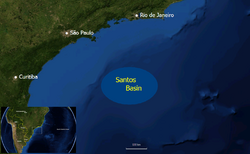Earth:Iguape Formation
| Iguape Formation Stratigraphic range: Paleocene-Pliocene ~65–2.6 Ma | |
|---|---|
| Type | Geological formation |
| Unit of | Itamambuca Group |
| Underlies | Sepetiba Formation |
| Overlies | Santos Fm., Itajaí-Açu Fm., Juréia Fm. |
| Thickness | up to 2,200 m (7,200 ft) |
| Lithology | |
| Primary | Calcarenite |
| Other | Shale, marl, siltstone, conglomerate |
| Location | |
| Coordinates | [ ⚑ ] : 26°6′S 43°43′W / 26.1°S 43.717°W |
| Region | Santos Basin, South Atlantic |
| Country | |
| Type section | |
| Named for | Iguape |
 Location of the Santos Basin | |
The Iguape Formation (Portuguese: Formacão Iguape) is a geological formation of the Santos Basin offshore of the Brazil ian states of Rio de Janeiro, São Paulo, Paraná and Santa Catarina. The calcarenite, shale, siltstone, marl and conglomerate formation dates to the Tertiary period and has a maximum thickness of 2,200 metres (7,200 ft).
Etymology
The formation is named after Iguape, São Paulo.
Description
The Iguape Formation is 1,103 to 2,200 metres (3,619 to 7,218 ft) thick,[1] and consists of bioclastic calcarenites and calcirudites, containing bryozoa, echinoids, corals, foraminifera, fragmented shells, and algae remains. They are interbedded with grey-greenish clays, siltstones, marls and variegated grey fine-to-medium grained conglomerates. These facies are interbedded with and change laterally to the Marambaia Formation. The depositional environment is thought to be a marine carbonate platform, influenced by the arrival of alluvial clastics in the most proximal areas. Biostratigraphic data from planktonic foraminifera, calcareous nannofossils and palynomorphs indicate a Tertiary age.[2] Carbonate production rates of the formation have been estimated at 50 to 55 metres (164 to 180 ft) per million years.[3]
See also
- Campos Basin
References
Bibliography
- Clemente, Pilar. 2013. Petroleum geology of the Campos and Santos basins, Lower Cretaceous Brazilian sector of the South Atlantic margin, 1–33. Danmarks Tekniske Universitet. Accessed 2017-09-04.
- Contreras, Jorham. 2011. Seismo-stratigraphy and numerical basin modeling of the southern Brazilian continental margin (Campos, Santos, and Pelotas basins) (PhD thesis), 1–171. Ruprecht-Karls-Universität Heidelberg. Accessed 2017-09-04.
- Kiang Chang, Hung; Mario Luis Assine; Fernando Santos Corrêa; Julio Setsuo Tinen; Alexandre Campane Vidal, and Luzia Koike. 2008. Sistemas petrolíferos e modelos de acumulação de hidrocarbonetos na Bacia de Santos. Revista Brasileira de Geociências 38. 29–46. Accessed 2017-09-04.
 |

